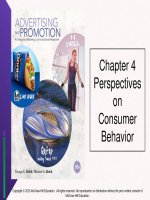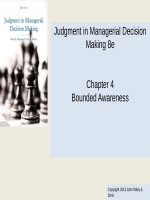Semantics chapter 4 PG
Bạn đang xem bản rút gọn của tài liệu. Xem và tải ngay bản đầy đủ của tài liệu tại đây (648.88 KB, 37 trang )
CHAPTER IV
SENSE RELATIONS
CHAPTER OUTLINE
IV.1. Substitutional and combinatorial sense
relations
IV.2. Other types of sense relations
IV.3. Componential analysis
IV.4. Entailment and the truth of sentences
IV.1. SUBSTITUTIONAL AND COMBINATORIAL SENSE RELATIONS
Substitutional relations are those existing between members of the same
grammatical category such as noun, verb, adjective and adverb .
(paradigmatic relations)
The tall girl is nice / wonderful / difficult / tough.
IV.1. SUBSTITUTIONAL AND COMBINATORIAL SENSE RELATIONS
Combinatorial relations are those existing between items of different
grammatical categories, such as adjectives co-occuring with nouns.
(syntagmatic relations)
The tall girl is nice.
IV.2. OTHER TYPES OF SENSE RELATIONS
1. Hyponymy
2. Meronymy
3. Semantic fields
4. Paraphrases and contradiction
5. Lexical gaps
6. Marked and unmarked terms
1. HYPONYMY
The hyponym is the member whose intensional meaning is specific enough to
cover the meaning of the superordinate whereas the superordinate member is
the one whose extensional meaning is broad enough to cover the hyponym.
E.g. superordinate
hyponyms
flower
lily
tulip rose
jasmine
There was a fine old rocking-chair that his father used to sit in, a desk where he
wrote letters, a nest of small tables and a dark imposing bookcase. Now all this
furniture was to be sold, and with it his own past.
Rocking-chair, desk, bookcase (hyponyms-lower class), furniture (superordinateupper class)
Pneumonia has arrived with the cold and wet conditions. The illness is striking
everyone from infants to the elderly.
emotion
joy
hate
fear
grief
love
•
J. Lyons (1977) observes that hyponymy is a transitive relation. If X is a
hyponym of Y and Y is a hyponym of Z, then X is the hyponym of Z.
Cow is a hyponym of mammal.
Mammal is a hyponym of animal.
Cow is a hyponym of animal.
•
Hyponymy is related to synonymy in such a way that if X is a hyponym of Y
and Y is a hyponym of X, then X and Y are synonyms of each other.
Mercury and quicksilver are hyponyms of each other, then they are
synonyms.
2. MERONYMY
The relation of meronymy is a part-whole relation.
Car:
door, driving wheel
House: living room, bedroom, kitchen
Body: arm, face, chest, eye, hand, head
Now you must not think that at the bottom of the sea there is only white sand. No, here
grow the strangest plants and trees; their stems and leaves are so subtle that the slightest
current in the water makes them move, as if they were alive.
(Little Mermaid by Hans Christian Andersen)
-
The part-whole relation which holds between discrete referents is clearly
transitive. If something X is part of something Y which is part of something Z,
then X is described as part of Z.
The drive is part of the CPU, and the CPU is part of the computer. Thus, we
can speak about drive as part of the computer.
3. SEMANTIC FIELDS
There exists some form of organization inside the vocabulary of a language.
The value of a word is determined by defining it in relation to the value of
neighbouring or contrasting words
A semantic field is a set of interrelated senses based on a conceptual field or
spectrum.
black, white, red, green (color)
father, mother, brother, sister, uncle, aunt, etc.
(kinship terms)
• Words can be grouped either thematically or ideographically.
• Thematic grouping contains words of the same part of speech
which cover the same conceptual field like human body,
colour, military terms.
• Ideographic grouping may contain words of different parts of
speech but thematically related, e.g. describing a plan, a city, a
trip, a holiday.
WAYS OF ORGANIZING SEMANTICALLY SIMILAR ITEMS INTO
SEMANTIC FIELDS
There are various ways according to which semantically similar items are related to one
another:
(a) Items related by topics:
• Types of fruit: apples, oranges, grapes, bananas, pears, plums, etc.
• Pieces of furniture: seats, tables, beds, storage, etc.
• Terms of colour: blue, red, yellow, green, black, white, etc.
(b) Items similar in meaning:
• Ways of cooking: stew, boil, fry, steam, roast, grill, smoke, etc.
• Ways of looking: gaze, glance, peer, squint, stare, etc.
• Ways in which a liquid escapes from its container: drip, leak, ooze, run, seep, etc.
(c) Terms describing people whose weight is below normal: thin, bony, skinny, scrawny,
underweight,
emaciated, slender, slim, etc.
(d) Items which form pairs of antonyms: long/short, light/heavy, alive/dead, love/hate,
approve/disapprove, approve/disapprove, begin/end, inside/outside, upstairs/downstairs ,
etc.
(e) Items which form pairs or trios of synonyms: smart/bright/intelligent,
conserve/preserve/safeguard, fix / repair / mend, kind/sort/type/variety, happy/glad , etc.
(f) Items grouped as an activity or a process:
• Do the housework: clean the rooms, do the washing, iron the clothes, get the food, prepare a
meal, wash up, etc.
• Do research: make hypotheses, collect data, analyze data, get results and come to conclusions.
(g) Items classified according to:
- Sex:
Male: waiter, tiger, actor, host, landlord, sir, etc.
Female: waitress, tigress, actress, hostess, landlady, madam, etc.
- Age: grown-ups, adults, elderly people, middle-aged people, teenagers, children,
infants, babies, etc.
- Age and sex:
mare: [+female], [+fully grown]
bitch: [+female], [+fully grown]
4. PARAPHRASES AND CONTRADICTION
Paraphrase is the relationship where two propositions have the same
truth conditions.
E.g.
1a. I don’t like maths.
1b. I am not fond of maths.
2a. John is the parent of James.
2b. James is the child of John.
We can produce paraphrases by using synonyms.
I like music.
I am interested in music.
Differences
in
structures
can
also
produce
paraphrases.
I bought my wife a camera as a birthday present.
I bought a camera as a birthday present for my
wife.
Paraphrases can be defined in terms of entailment. If sentence X entails
sentence Y and sentence Y entails sentence X, and X and Y are
paraphrases of each other.
It seems that she is a good boss.
She seems to be a good boss.
4. PARAPHRASES AND CONTRADICTION
Contradiction is a relationship where a proposition must be
false because of the meanings of the words involved.
E.g.
1. He is both married and single.
2. That cat is a dog.
5. LEXICAL GAPS
Lexical gap is used to refer to the absence of a lexeme/word at a
particular place in the structure of a lexical field.
There are two cases of lexical gaps:
(i) there is co-hyponymy without an existing superordinate lexeme,
(ii) there is a lack of co-hyponymy
___
Corpse
(body of a dead
human being)
Carcass
(body of a dead
animal)
a dead tree
6. MARKED AND UNMARKED TERM
-
-
Markedness is formal because it is based on the presence or absence of some
particular element of form.
hat (unmarked) vs. hats (marked)
lion vs lioness
happy vs unhappy
Marking may be semantic, where the unmarked member has a more general
sense.
old vs young
far vs near
tall vs short
Dog (male/female - unmarked) vs bitch (female marked)
IV.3. COMPONENTIAL ANALYSIS (CA)
-
Componential analysis is a way of formalizing, or making absolute precise,
the sense relations that hold between words or lexemes.
-
Componential analysis is grounded in structuralism, which says that the
sense or meaning of an expression is the totality of its possible relations with
all other words.









